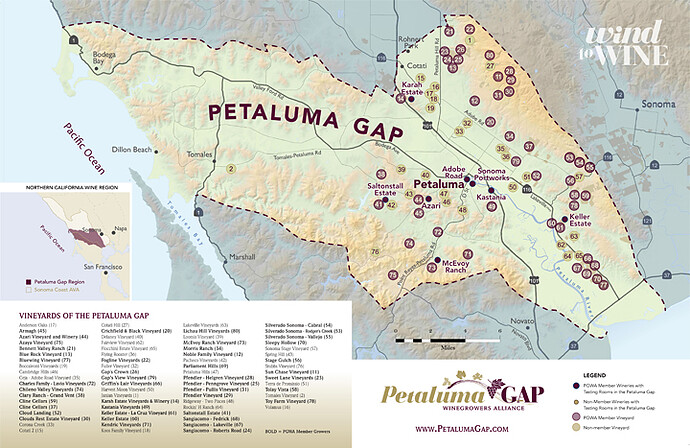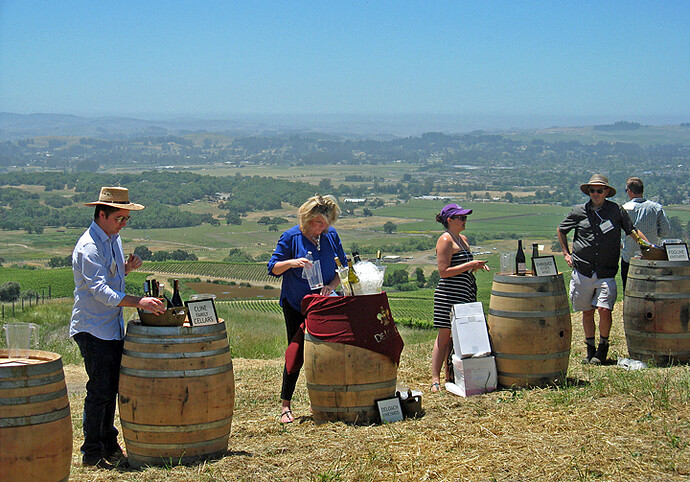Petaluma Gap AVA Celebration – May 29th, 2018
I attended the Petaluma Gap AVA Celebration in late May and wrote a report for the Grape-Nutz.com website. An abbreviated version of the report is below – there are more photos plus tasting impressions from 17 wineries here: Petaluma Gap AVA Celebration – May 29th, 2018

Report on Petaluma Gap AVA Celebration, held on Tuesday May 29th, 2018 at Gap’s Crown Vineyard in Penngrove, California. This was a special event to celebrate the recent establishment of the Petaluma Gap AVA, and it included an informal trade / media tasting of wines made from Petaluma Gap fruit.
The event was organized by the Petaluma Gap Winegrowers Alliance (PGWA), with assistance from main sponsor American AgCredit as well as many other sponsors and contributors. Founded in 2005, the PGWA is an organization of wineries, growers, and other associate members. The PGWA seeks to promote the growers and vintners who work with the region’s winegrapes, and to increase public awareness of the area’s history and current practices in grapegrowing and winemaking. Justin Seidenfeld of Rodney Strong Vineyards is the current PGWA president.
Located in the southern portion of the large Sonoma Coast AVA and extending into the northern part of Marin County, the region’s name refers to the 15-mile wide gap in the coastal mountains that draws cool air from the Pacific Ocean and funnels it toward San Pablo Bay. The resulting wind that this creates is considered one of the Petaluma Gap’s defining climatic characteristics, as is the morning and late-afternoon fog that often blankets much of the area, helping to make it one of the coolest winegrape-growing regions in California.
Map from Petaluma Gap Winegrowers Alliance website (http://petalumagap.com/)
The area’s first commercial winery was established in 1884. There were grapevines planted there earlier, though no pre-1900 vines still exist in the region. The Petaluma Gap is currently home to over 80 vineyards covering over 4,000 acres, with Pinot Noir, Chardonnay, and Syrah being the most widely-planted grape varieties. Most of the Petaluma Gap’s vineyards are located in a band that’s bounded roughly by the 101 freeway and the Petaluma River on the west and Sonoma Mountain to the east, running between Cotati and Rohnert Park on the north and almost to Highway 37 near San Pablo Bay in the south. A smaller group of vineyards is located west and southwest of Petaluma, and includes the handful of sites in northern Marin County.
Tasting Impressions
Everyone parked just inside the entry gate to Gap’s Crown Vineyard, and we were shuttled to the tasting site on a couple of small busses. The site was up near the high point of the vineyard, and it was a steep climb on a dirt road – not easy for the busses loaded with people to make it but they managed. There was a tremendous view from the site, overlooking the vineyard below and far beyond to the west. Participating wineries were set up along two lines of individual upright barrels to pour their wines. With the warm afternoon – about 80 degrees – it would have been nice to have some shade, but everyone came prepared with plenty of ice to cool down their wines, and they managed pretty well. There were a few shaded food tables in a central area between the two lines of winery barrels, with cheese from Achadinha Cheese Company and Cowgirl Creamery in Petaluma, and small bites prepared by Kin Restaurant in Windsor to go with the Petaluma Gap wines.
Once most of the attendees had been ferried up the hillside, there was a brief ceremony to mark the official establishment of the Petaluma Gap AVA. Work on a petition to establish the AVA began in 2014, and the petition to the TTB was submitted in early 2015. After several years of analysis, review, and public comments, the Petaluma Gap AVA was approved in December 2017. Among the people who spoke at the ceremony were two local members of the US Congress, Jared Huffman and Mark Thompson (Congressman Thompson is the co-founder and co-chair of the bipartisan Congressional Wine Caucus). PGWA president Justin Seidenfeld noted that both Congressmen were particularly helpful in keeping the petition for AVA approval on track.
Since this was a trade / media tasting rather than being open to the public, there were no big crowds to contend with, making this a relaxed and informal event. The PGWA currently includes over 30 member wineries, and most of them poured their wines at the AVA Celebration. As is the case with many other region-based organizations such as the PGWA, not all of the wineries themselves are located within the Petaluma Gap but still source fruit from there. Some of the newest bottlings at the tasting carried the Petaluma Gap AVA designation on their labels while those bottled before the appellation was approved were labeled as Sonoma Coast or Marin County.
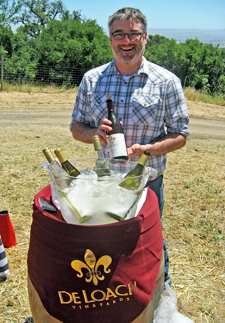
Brian Maloney, DeLoach Vineyards
I managed to taste wines from 19 out of about 24 wineries that poured at the tasting, and the accompanying notes cover most of the producers I tried. I went in roughly alphabetical order of producers, and some toward the end were already out of many or all of their wines by the time I got to them. Most of the wines that were poured were current releases, though there were also a few library and pre-release bottlings. As expected for the Petaluma Gap region, the tasting was heavy on Pinot Noir and Chardonnay, though there was also Syrah, Riesling, Viognier, Tempranillo, a red Bordeaux-style blend, a couple of rosés, and two interesting field blends.
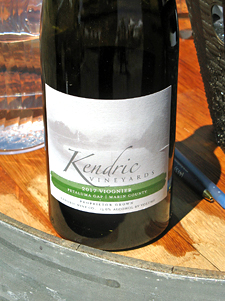
Overall, the wines at the tasting were very good, with quite a few standouts given the number of wines that were poured. Producers that poured particularly strong line-ups included Brooks Note, DeLoach, Fogline, Guarachi, Keller, and Kendric, with Cline and Karah close behind.
This was an enjoyable tasting with a lot of good wines from the Petaluma Gap. The area’s defining wind and fog help the grapes to retain plenty of acidity, while the wines often feature ripe fruit and an earthy character along with good structure. The Petaluma Gap has been thought of as a distinct winegrape growing region for a number of years, and it is certainly deserving of AVA status – this event was an excellent way to celebrate.
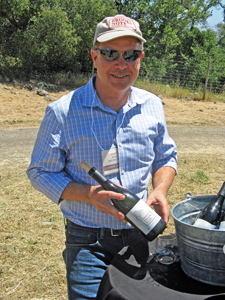
Garry Brooks, Brooks Note Winery
Favorites
Whites and Rosés
Cline 2016 “Amphora Chiaro Bianco” Estate Viognier
DeLoach 2017 Marin County Riesling
Fogline 2017 Zephyr’s Block Estate Chardonnay
Guarachi 2016 Sun Chase Vineyard Chardonnay
Karah 2017 Estate Rosé of Pinot Noir
Keller 2015 La Cruz Vineyard Chardonnay
Kendric 2017 Estate Viognier
Reds
Brooks Note 2015 Marin County Pinot Noir
Brooks Note 2016 Azaya Ranch Pinot Noir
DeLoach 2014 Marin County Pinot Noir
Fogline 2014 Hillside Estate Pinot Noir
Guarachi 2016 Sun Chase Vineyard Pinot Noir
Keller 2015 “El Coro” Pinot Noir
Kendric 2016 Estate Pinot Noir
McEvoy Ranch 2014 “Red Piano” Syrah
Sojourn 2016 Rodgers Creek Vineyard Pinot Noir
Three Sticks 2015 Gap’s Crown Vineyard Pinot Noir
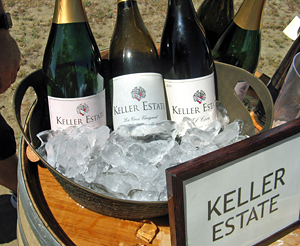
Others of Note
Brooks Note 2016 Marin County Pinot Noir
Calstar 2012 Sangiacomo Vineyard Pinot Noir
Cline 2015 “Amphora Furvus Rosso” Estate Syrah
Emblem 2016 Sonoma Coast Chardonnay (Michael Mondavi)
Enriquez 2013 “Brisa”
Fogline 2017 Cloud Twelve Vineyard Rosé of Syrah
Karah 2016 Estate Pinot Noir
Kastania 2013 “Proprietor’s Blend”
DeLoach 2014 Stubbs Vineyard Chardonnay
Trombetta 2014 Gap’s Crown Pinot Noir
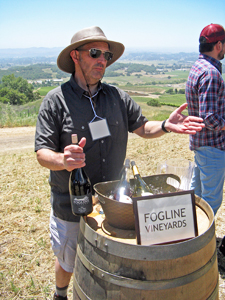
Evan Pontoriero, Fogline Vineyards
